These paleo and Whole30 compatible Asian Meatballs are packed with flavor and perfect for meal prep or game day appetizer!
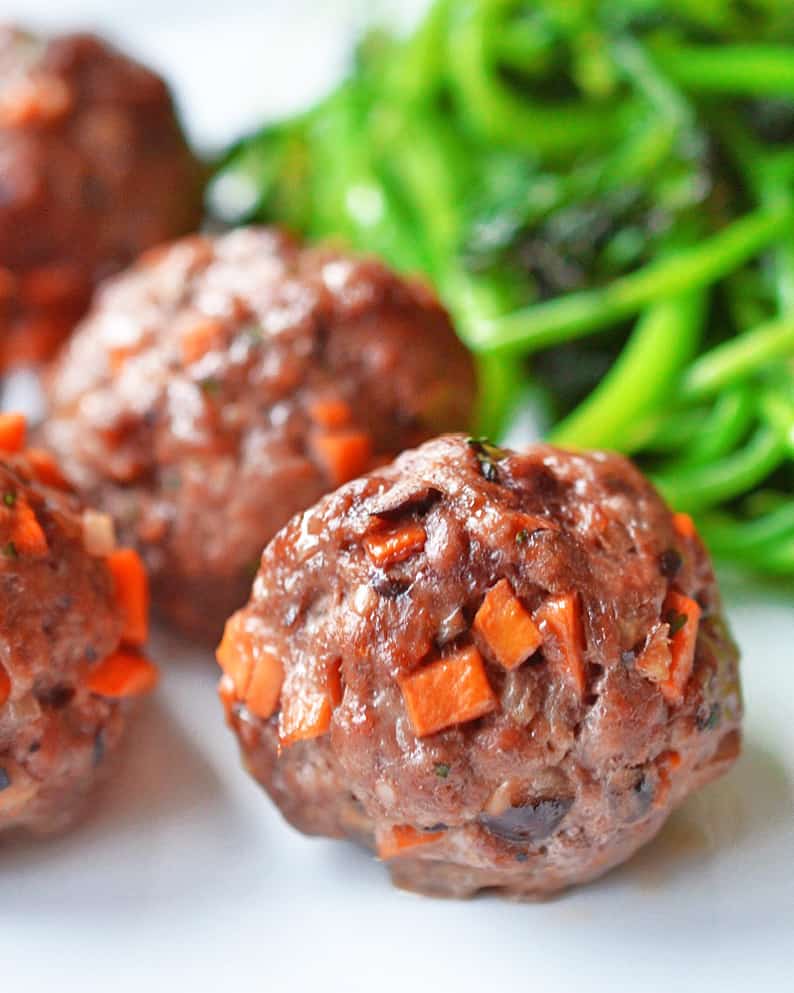
Table of Contents
The best and easiest Asian meatballs
This East-West fusion-inspired take on classic Sunday meatballs is a hit with our entire family. These savory balls of meat and minced vegetables are a cinch to prepare, and each bite is bursting with umami from the mushrooms, fish sauce, and tomato paste. (What can I say? This mommy knows umami.)
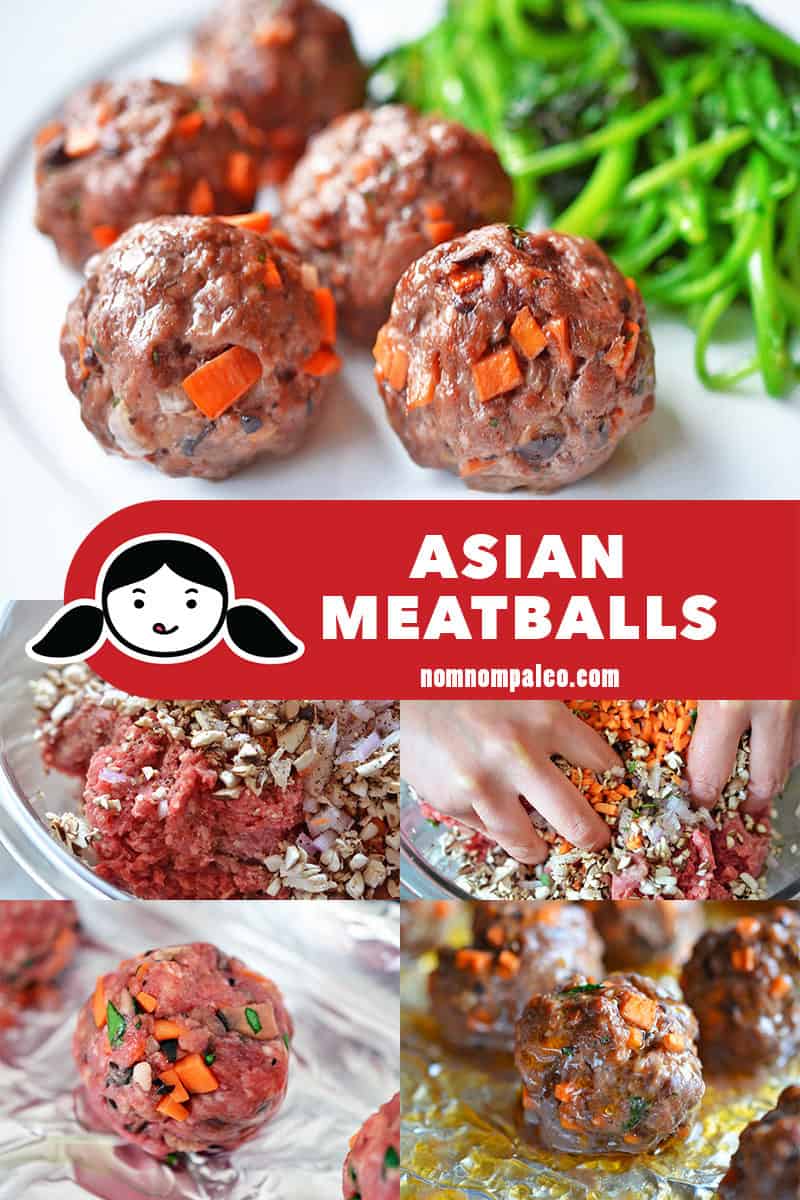
Make a double batch, and you’ll have a fantastically versatile emergency protein that you can use throughout the week to accompany big salads, zoodles, or simple cauliflower “rice.” Or just pop a few meatballs into a container and bring ‘em to work as a handy snack.
What’s Umami?
Before we get down to brass tacks, I should probably explain what “umami” is all about – and why I’m such a big fan of umami boosters like Paleo-friendly fish sauce, mushrooms, and tomatoes.
The Fifth Taste
Until the late 1800s, the conventional wisdom was that there were only four fundamental tastes: Sweet, salty, sour, and bitter. But then Auguste Escoffier came along. Escoffier, the author of Le Guide Culinaire and one of the greatest chefs of his time, began serving up dishes that tasted like nothing anyone had experienced before. His secret ingredient was a stock made of veal that he invented. Foods cooked with Escoffier’s veal stock tasted more robust, complex, and satisfying – but the veal stock itself wasn’t sweet, salty, sour, or bitter. Escoffier had actually stumbled upon the fifth taste: Umami.

Japanese Named It Umami
In Japanese, “umami” means “deliciousness,” and describes a robust, savory, mouth-filling quality to food. Why did Japan get the naming rights? Because although Escoffier was wowing rich European diners with his umami-packed dishes, no one could put their finger on this fifth taste until a chemist at the University of Tokyo named Kikunae Ikeda did some detective work. For generations, Japanese cooks had used a seaweed stock called dashi to imbue their food with a unique richness. Intrigued by this effect, Ikeda did some digging, and finally uncovered the source of this wonderful flavor: A chemical compound called glutamate and ribonucleotides like inosinate and guanylate.

What Foods Have Umami?
Glutamate occurs naturally in most savory foods, including animals and vegetables. But we don’t sense the wonderfully mouth-filling umami flavor until the organic matter starts to break down (through ripening, cooking, aging, or fermentation), and the glutamic acid is converted into the salt form, L-glutamate. When that happens, the umami kicks in. Mushrooms, asparagus, tomatoes, anchovies, and bacon are all rich in L-glutamate, making them crazy-good flavor enhancers. When something tastes insanely awesome in a way that’s not sweet, salty, sour, or bitter, you’re experiencing umami.
Fish Sauce is Bottled Umami
Umami is the reason I’m such a huge fan of fish sauce (called nước mắm in Vietnamese). It’s a staple ingredient in a number of Southeast Asian cultures. Anchovies and salt are allowed to ferment in wooden barrels and then slowly pressed to produce the intense, savory liquid. Yes, it sounds a little gross, but I love fish sauce. Just a splash of the stuff can lend a deep umami quality to all your dishes – not just the Asian ones.

Red Boat is my favorite Whole30 fish sauce
Unfortunately, most of the fish sauce found in supermarkets and Asian grocery stores are full of additives: Hydrolyzed wheat protein, sugar, MSG, chemical preservatives – you name it. But many years ago, my super-chef sister pointed me in the direction of Red Boat Fish Sauce – made with just black anchovies and salt, and I immediately fell in love. I’ve been spreading the gospel of Red Boat Fish Sauce ever since, and it’s now become one of the most potent and popular flavor weapons in Paleo kitchens everywhere. It’s even Whole30 approved!
My Asian Meatballs recipe is a great example of the power of umami.
Ingredients
- Fresh shiitake mushrooms or dried shiitake mushrooms (rehydrated)
- Shallot: You can substitute green onions or diced white onions in place of shallots.
- Sweet potato: I always just use orange fleshed sweet potatoes and it turns out great.
- Cilantro
- Ground beef: Ground turkey, ground chicken, or ground pork also work!
- Paleo-friendly fish sauce: If you don’t want to use fish sauce, you can use coconut aminos (my preferred soy sauce substitute).
- Tomato paste
- Magic Mushroom Powder or Diamond Crystal brand kosher salt
- Freshly-ground black pepper
How to make Asian Meatballs
Line two rimmed baking sheets with parchment paper or foil, and preheat the oven to 375°F. In the meantime, finely mince the mushrooms, shallot, sweet potato, and cilantro.
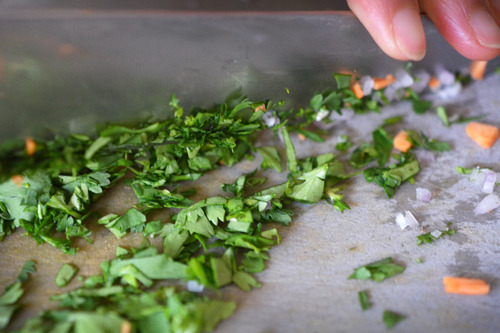
In a large bowl, combine the ground beef, fish sauce, tomato paste, and the minced veggies and herbs. Sprinkle on Magic Mushroom Powder (or kosher salt) and pepper. If you’re unsure of how much seasoning to use, start with ½ teaspoon Magic Mushroom Powder (or kosher salt) and a few grinds of freshly ground black pepper.
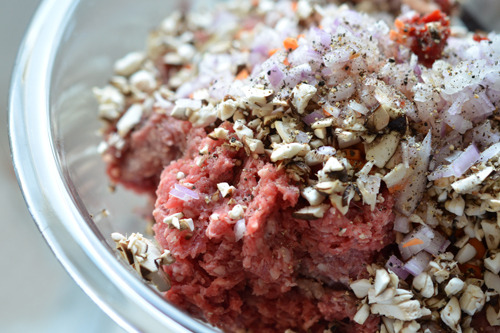
Thoroughly combine the meatball ingredients but don’t overwork the meat.
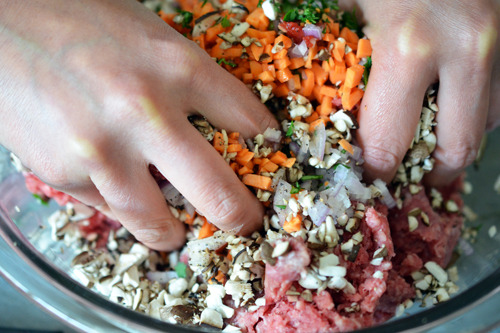
To check if your seasoning is correct, form and fry a mini patty. Chow it down and adjust the meatball mixture for additional salt and pepper if needed.
Scoop out uniform balls with a medium disher (1½ tablespoons) and roll out three dozen meatballs. Each meatball should be about 1½ inches in diameter. (If you’re not using parchment paper, brush the foil or baking sheet with the melted fat before you place the meatballs on top.)
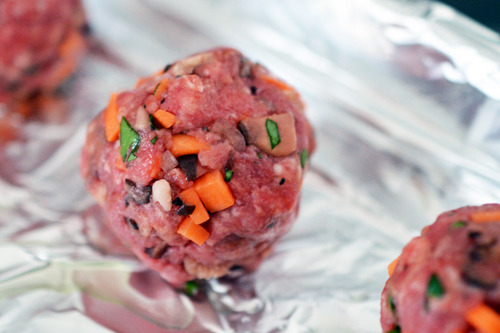
Divide the meatballs onto the two lined baking sheets. Bake each tray of meatballs for 15 to 20 minutes, rotating the tray at the midpoint to ensure even cooking.
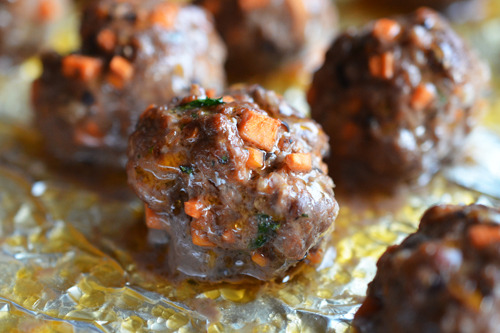
Plate and serve immediately!
How to save leftovers
Store leftovers in an airtight container in the fridge for up to four days. You can also freeze the cooked meatballs for up to 6 months. Simply freeze them in a single layer and then place the solid orbs in a freezer bag or sealed container.
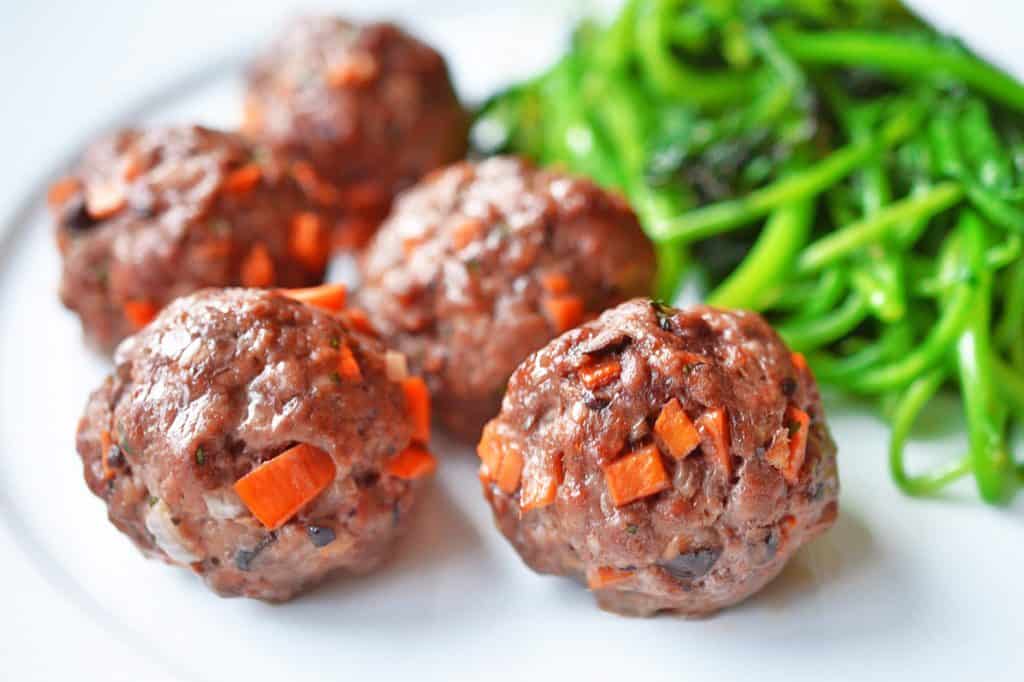
These Asian meatballs are perfect for meal prep!
More paleo meatball recipes
Looking for more recipe ideas? Head on over to my Recipe Index. You’ll also find exclusive recipes in my cookbooks, Nom Nom Paleo: Food for Humans (Andrews McMeel Publishing 2013), Ready or Not! (Andrews McMeel Publishing 2017), and Nom Nom Paleo: Let’s Go! (Andrews McMeel Publishing 2022).
PRINTER-FRIENDLY RECIPE CARD
Asian Meatballs

Ingredients
- 8 medium fresh shiitake mushrooms minced (or 8 dried shiitake mushrooms, rehydrated)
- 1 medium shallot minced
- ¾ cup minced sweet potato
- 2 tablespoons minced cilantro
- 2 pounds ground beef
- 1½ tablespoons Red Boat fish sauce
- 2 tablespoons tomato paste
- Magic Mushroom Powder or Diamond Crystal kosher salt
- Freshly-ground black pepper
- 2 tablespoons melted fat of choice unnecessary if using parchment paper
Instructions
- Line two rimmed baking sheets with parchment paper or foil, and preheat the oven to 375°F. In the meantime, finely mince the mushrooms, shallot, sweet potato, and cilantro.
- In a large bowl, combine the ground beef, fish sauce, tomato paste, and the minced veggies and herbs. Sprinkle on Magic Mushroom Powder (or kosher salt) and pepper. If you’re unsure of how much seasoning to use, start with ½ teaspoon Magic Mushroom Powder (or kosher salt) and a few grinds of freshly ground black pepper. Thoroughly combine the ingredients but don’t overwork the meat.
- To check if your seasoning is correct, form and fry a mini patty. Chow it down and adjust the meatball mixture for additional salt and pepper if needed.
- Scoop out uniform balls with a medium disher (1½ tablespoons) and roll out three dozen meatballs. Each meatball should be about 1½ inches in diameter. (If you’re not using parchment paper, brush the foil or baking sheet with the melted fat before you place the meatballs on top.)
- Divide the meatballs onto the two lined baking sheets. Bake each tray of meatballs for 15 to 20 minutes, rotating the tray at the midpoint to ensure even cooking.
- Plate and serve immediately, or store in an airtight container in the fridge for up to three days. You can also freeze the cooked meatballs for up to 6 months. Simply freeze them in a single layer and then place the solid orbs in a freezer bag or sealed container.
Nutrition
Nutrition information is automatically calculated, so should only be used as an approximation.

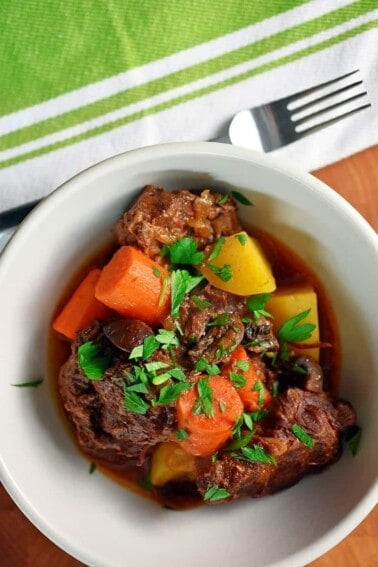
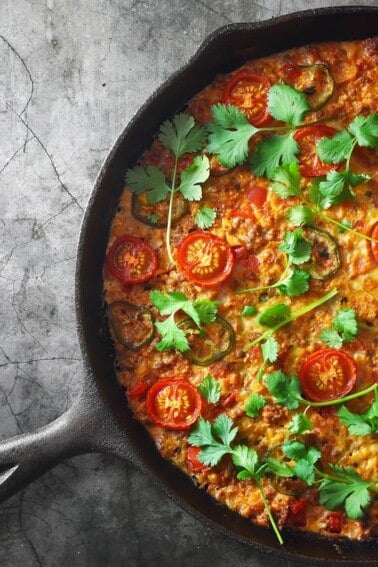
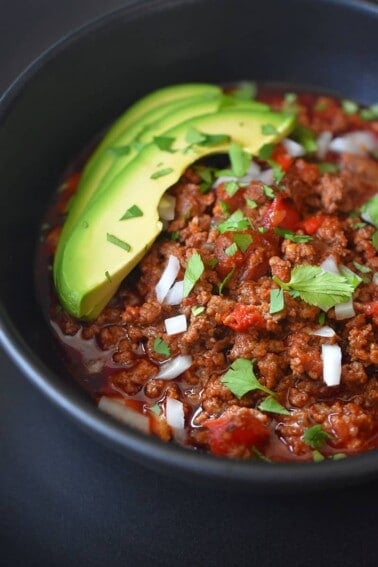
Is there any type of sauce you could dip them in for an appetizer?
You can try my All-Purpose Stir-Fry Sauce or Sesame Ginger Dressing!
I’ve been using your recipe for these meatballs for years. We make them exactly as written and they are an all-time favorite in this house. We love love love them.
The are SOOO good!!! What would be a good substitute for the sweet potatoes for a keto eater in my household?
You could use carrots or leave it out all together.
l would love to try meatballs recipe this way. Thanks for sharing.
Your meatballs sound delicious, I’m planning to make them this week. Do you think they would turn out okay using a good processor to cut up the veggies? I have limited energy and that much cutting is challenging.
You can definitely chop up the veggies in a food processor! I do it all the time!
Delicious recipe!! I made this with white rice and it was perfect! Can’t wait for leftovers.